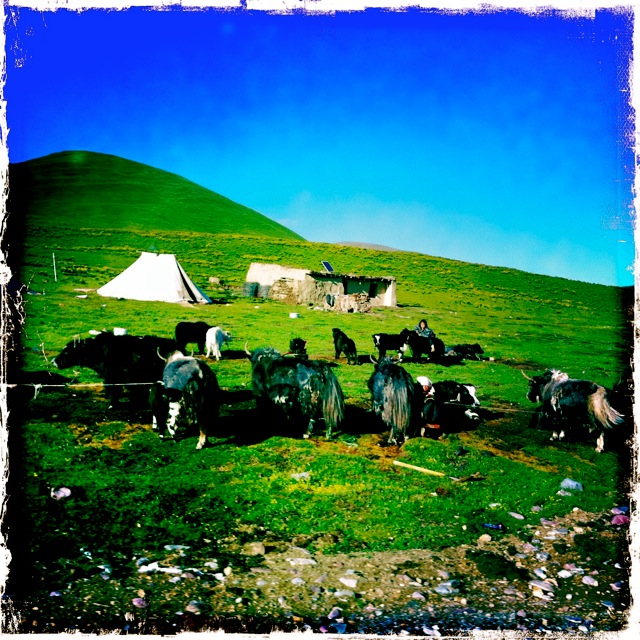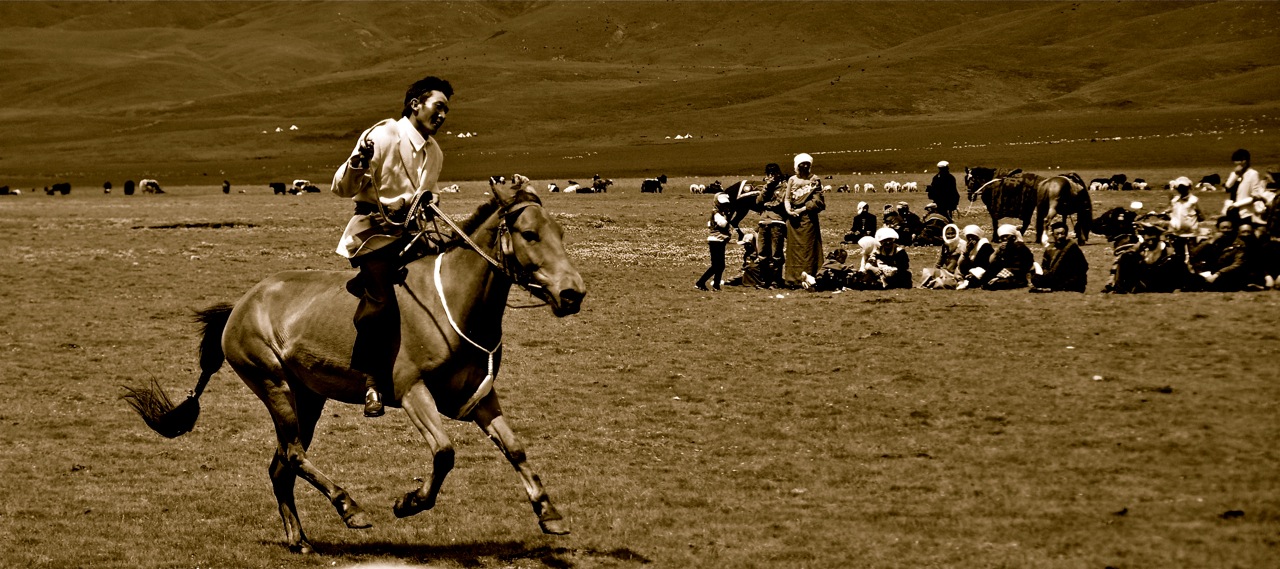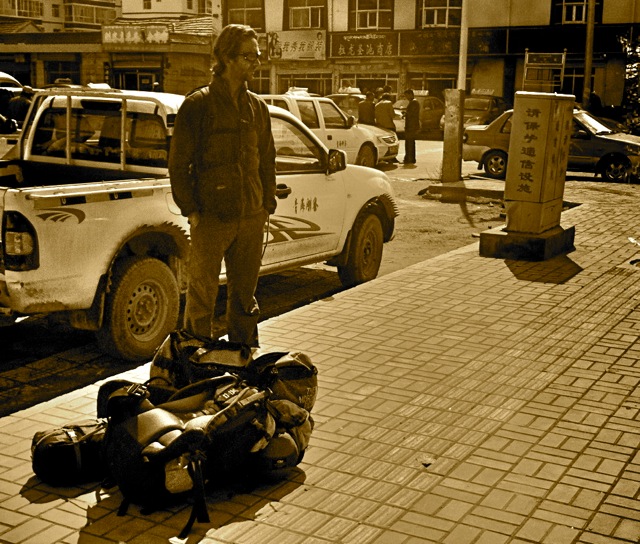Qinghai or for the Tibetans, Amdo – Michael and I have entered from the eastern Gansu border by that ‘everywhere’ mode of transportation in this part of the world, the bus. The struggle is as usual present; coming out of rugged, silent hinterlands and into a world of chaos and hordes where the mind has to cope with what is and isn’t essential…and much is very ‘unessential’.
Our collective intention is clear and we make haste to get ‘out’ of the city and into big sky country where horizons are a clear line…the moment we arrive to the dusty bulk of the capital of Xining, we hire a driver to take us west to a lake that is known to Mongolians as Kokonor, to the Tibetans as Tso Humbo (Blue Lake) and to the Han as Qinghai Hu. It is regardless of its name the largest lake within China proper and our direction is northwest towards Gansa, which lies northeast of the great blue liquid mass.

On one of Gansa's many corners a gaggle of men sell everything that the local land provides, including what we know as Cashmere and yak wool
Gansa seems to have erupted out of a flatland. Like many locales in these slightly destitute lands one needs an imagination (or perhaps it is my need to find a more pleasant memory of the place) to try and see beneath the newly erected plastic looking façade. There are always the tell-tale shacks and buildings on the fringes which hint at what once was and Gansa is no different. Everything is ‘new’ but little of what we see is at all natural looking. On the outskirts of the town mud huts and tents become the norm, though I imagine they too in time will be something of the past.

Nomads homes offer up proof-positive of the old adage of what is not essential is not taken. A small solar panel rests atop the solid structure
After a night spent in a room smelling of a century of dirty socks, along with a bizarrely ornate rug, we are up the next morning with a bit of zip and fire in us…we will head into the high flatlands, back into nomadic country. Regardless of aches and tiredness that filters down through the days, we are always primed whenever we are heading into ‘empty’ lands.
Off to the right of the road we have been thrown around upon for hours, a multi-coloured collection of nomads huddle. Ornate braids line women’s backs, broad shouldered men with knives which hang in a kind of reckless homage to the past days of fast wits and faster hands.
Horses stand in knots, gleaming and frisky. The highlight of this informal horse festival will be a series of long distance races much as they do in Mongolia – the horse and riders are matched and in many cases the four-legged winner might have offers to buy it. Much of Mongolian culture influenced and even conquered these portions, only to fall back into the equally formidable locals’ hands.
 A horseman arrives with his four-legged mate at the end of the race exhausted. He is bareback on the horse in a tribute to the past
A horseman arrives with his four-legged mate at the end of the race exhausted. He is bareback on the horse in a tribute to the past
Deeper we travel into the angled mountains and rains track our progress. Earlier we had been held up on our journey when, with no warning whatsoever, a nomad weaved his motorcycle into our path. What I thought would be an epic crash became a nasty crunch as bounced him and his bike a metre or two. Clearly the nomad’s fault prevailing laws meant that our driver was ultimately responsible and what ensued is part of the great theatrical web of this part of Asia.
After we made sure that the nomad driver was ok, part two of the performance begins with recriminations flying back and forth in a kind of gentle aggression…everyone knowing all the while that our own driver will have to pay up some kind of compensation.

People gather at the sight of our unfortunate accident. The gathering increased pushing up the amount that would be payed - such is the way here
Fellow nomads file in and soon the entire road is blocked with people stopping to get in and see the action – even in this remote little corner or the world. There is one point, one brief moment when I wonder if things will get a tad nasty. A bulky Tibetan who has arrived late, wired and entirely drunk, tries to reignite the entire drama by insinuating all sorts of things. Cooler heads prevail ultimately and a fee is payed and the nomadic driver is shuttled off to mend the leg.
Wandering along I often think on the ways that geography affect the mind, the lives and the aspirations of people. Here with sheer masses of ‘emptiness’, where the sky and earth and yak dung come together, everything seems tangible and touchable. I wonder too if this isn’t one of the reasons (and draws for me) to these lands and peoples – that they are so tangible.
 Given this space this way of living, it is hard to imagine a ‘people of the earth’ without their traditional ways.
Given this space this way of living, it is hard to imagine a ‘people of the earth’ without their traditional ways.
At one point off to our left a straight line seems out of place on the huge gap of space. Finally and almost impossibly it comes into focus. A railway coasts above the landscape on stilts. Even here amidst all of this green and sun this sleek transport convener finds a home. We continue until finally the rail and its geometry happily disappear from our view.
 A railway line out of nowhere bisects the valley
A railway line out of nowhere bisects the valley




“Wandering along I often think on the ways that geography affect the mind, the lives and the aspirations of people. ” Living for the moment in New Mexico, I often speculate that the people who grow up in the grasslands east of the mountains must be rich in imagination. The mind strives to fill in all that empty space. Little wonder that UFOs are seen in the skies, or that oilmen want to control a world whose reaches stretch away in every direction.
This point about the imagination is I think crucial. When ‘facts’ don’t cloud the mind and eye the world around these ‘people of the land’ opens up possibilities, hopes and dreams….and as you mention the mind tries to “fill in all that empty space”.
Jeff